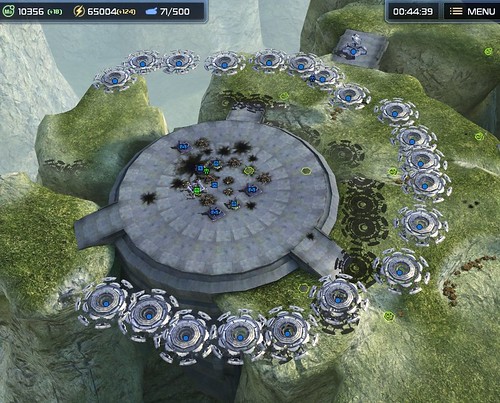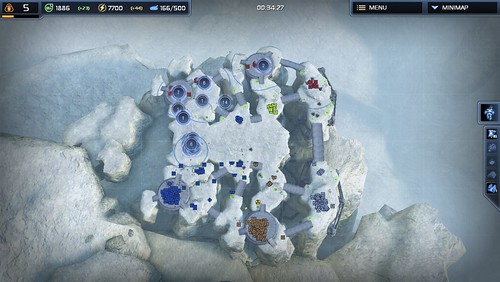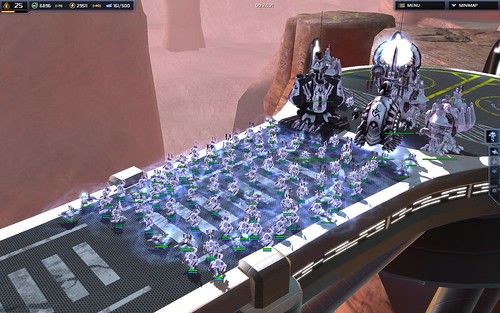TOM FRANCIS
REGRETS THIS ALREADY
Hello! I'm Tom. I'm a game designer, writer, and programmer on Gunpoint, Heat Signature, and Tactical Breach Wizards. Here's some more info on all the games I've worked on, here are the videos I make on YouTube, and here are two short stories I wrote for the Machine of Death collections.
Theme
By me. Uses Adaptive Images by Matt Wilcox.
Search
Day Off
Built twenty Darkenoid saucers to create a laser embargo around the AI while I stole everything they built with a Loyalty Cannon.
Making Nuclear War More Interesting In SupCom 2
The notable thing about Supreme Commander was that it let you march a thousand robots around a 640,000 sq km battlefield – more like a county, actually. Supreme Commander 2 doesn’t let you do that, so the initial reaction is ‘Oh.’ But it’s still leagues ahead of every comparable strategy game in scale, control, and stompiness of robots.
The upside of all the scalebacks is primarily speed. It doesn’t really matter whether you pay for the stuff you build gradually (SupCom) or upfront (SupCom2). SupCom2 cuts out the interminable upgrading process to spectacularly accelerate how quickly you can build something vast, gleaming and capable of a war crime. It’s a less remarkable game, but a much more playable one. And even though its matches unfold eight times faster, I’ve already sunk more hours into it than the first.
A few things stop it from completely replacing the first game, most prominently the scale. A few things stop it from being the perfect evolution of the real-time strategy; a few signs of timidity in the Research options. And a few things stop me from really wanting to play it online with strangers – it appeals more than any other RTS in that way, but I still have to customise it a little to be happy with the playing field. So I wrote a few posts about how to fix all these things.
Some of the basic stuff probably isn’t controversial: it needs more eight player maps, two or three ten player ones, more sea maps, and more sea in the sea maps. AI that doesn’t build more transports than it can fill, and a ‘Very Hard’ AI that builds Experimentals with near-perfect efficiency. And a visible build queue, so that things don’t have to be paid for until they start construction, you can see what’s going to drain your resources, tasks can be reordered, and repeat-building factories can start churning out units again when nothing else is sapping your resources.
The Research tree of upgrades you can unlock is a wonderful improvement over the usual nonsense, but they’ve needlessly lost that concept of truly elite units. Experimentals are a different kind of “Fuck you” to the classic “Fuck you, one of my tanks can kill ten of yours.”
Upgrades should be more specific, more significant and more visible. The five incremental ‘Training’ upgrades should be cut to two very expensive ones that each double the units’ effectiveness, and make them physically bigger. It has to be immediately obvious “Shit, that’s an upgraded tank” or “Holy shit, that’s a maxed-out tank”. It should also be different for each race: UEF’s should upgrade health more than damage, Cybran damage more than health, Illuminate damage, health and range.
And scrap all generic ‘damage’, ‘health’ or ‘rate of fire’ upgrades – that’s what Training’s for. They should be replaced by unit-specific upgrades that change their form, size and function more dramatically. So instead of “+30% damage to all turrets” you’d have “Anti-air turrets upgraded to surface-to-air missile launchers, increasing their range and damage and letting them lock on to fast aircraft.”
Every upgrade needs to make a visual difference that’s obvious from any zoom level where you can see the model. Training increases size, a new weapon type changes the shape of the unit and adds an effect, regen causes them to spark colourfully when healing, etc.
This has been a huge problem for me in both games. Because it’s nuclear war, but it’s boring. Either side can build a nuclear missile, but either side can also build an anti-nuclear missile for half the price. The only reason not to is that half the price of a nuke is still significant. So an actual nuclear war is just a contest of who can be bothered to click their button the most, and since the defender has an economic advantage, it’s almost always him. The only time nukes actually get used is when your opponent is too new, stupid or artificial to know to build anti-nukes. Top marks for matching reality, zero marks for fun.
The only good moments we’ve had with them have been when, in co-op, a stupid AI has built their only nuke defense on the fringe of their base. One player readies a nuke, the others send in a combined strike team to take out the defense silo, and the moment they’re successful, you launch. Awesome. But in normal play, a strike force capable of taking down a massively tough nuke defense silo in the middle of the enemy base is also a strike force capable of taking down the base itself. Here’s my proposal:
All factions should be able to build a basic Nuke Defense silo without having to research or unlock it. It has unlimited anti-nukes, but it can only fire one at a time, and they don’t neutralise the nuke: they detonate it. So to avoid just blowing yourself up in a slightly different way, you have to build it well outside your base, and defend it with stuff you can afford to lose or move. The silo itself is nuke-proof – it’s basically a bunker – so you don’t have to rebuild it each time.
The idea is to turn nuclear war into a fight, rather than who can be bothered to click more times. It’s easy to defend against nukes, but only if you can defend a forward position in regular combat. Accordingly, it’s harder to nuke someone if all you do is sit back and nuke, but it’s easier to take out nuke defense if you build a good strike force and use it well.
It also gets you thinking about which directions nukes can come from, and which directions you could launch yours from.
Not strictly necessary, but it’d also be nice if each race had a unique second way of delivering a nuke. Each would bypass nuke defense, but be counterable by conventional units: again, more of a fight than a discrete “I clicked more times” system.
UEF build a Nuclear Bomber that must get close to its target intact to drop its payload. Anti-air can take it out quickly, and the nuke won’t detonate, so advance forces need to take out most AA defenses.
Cybran have a Walking Nuke experimental: a huge, tough block on legs with no weaponry, but which explodes with nuclear force on death. You’ll want to escort it in to give it enough protection to survive, then abandon it so your own units aren’t caught in the blast.
The Illuminate can unlock an upgrade for the Space Temple that lets them fire a nuke into it to hit the teleport destination. But the marker has to be in place for thirty seconds, and the enemy can destroy it in that time if they have the firepower. It’s a test of their base’s defenses, so if you strike while their army’s on their way to you, you’ve got a better chance of delivery.
This has always been a personal crusade of mine – I hate fog of war. It doesn’t meaningfully represent any real element of war, since regular line of sight would cover the whole battlefield on almost any map, and in any game set in modern times or later, dozens of other intel methods would give a clear picture of the scenario. But more importantly, it hurts the game in so many ways. Its crimes:
- Making the whole game look dingy and claustrophobic
- Wasting years of work on beautiful unit models by replacing them with grey squares
- Mandating endless, arduous scouting with air units – all the less welcome in a game where Air is supposed to be one of many options rather than a mandatory tool
- Robbing you of the satisfation of seeing artillery smash an enemy base. It doesn’t even compensate you with the luxury of an icon vanishing if you don’t have realtime radar coverage.
The argument in favour, as I understand it, is to let you surprise the enemy by building something he doesn’t know is coming. If that works, it reduces the game to scissor/paper/stone – complete luck. If you can see what’s being built, you have time to adapt your strategy to include a counter, and so does the enemy. To me, that’s where strategy gets interesting.
I think the tricky element can be achieved in a more explicit and localised way: each faction should have their own method of deception.
UEF can unlock a decoy engineer: everything he builds is a cheap fake that looks real to the enemy. It fits their defensive nature by making them look bigger than they are, and leads to feints like building masses of real point defense, then letting the enemy catch you building a fake one to tempt him into a doomed rush.
Cybrans have a very high-tier Land upgrade to turn the Adaptor mobile shield opaque to the enemy, so they can cluster these to conceal land units. Stealth is broken when it takes just a few hits, though, and doesn’t regenerate when the shield does.
Illuminate can Research an upgrade that makes all their experimentals appear to the enemy as regular units of a similar type, only revealing their true form and power when attacked. They already have a deceptive edge in that their Experimental factory is the same for all types of Experimental, so you can’t tell what they’re planning to build.
I also had some ideas for how a high-level campaign map could work for the single-player, and a redesign of the Illuminate to make them feel less toothless. But those are probably separate posts.








